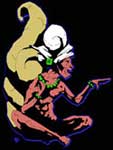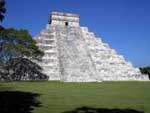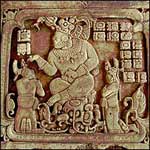Land of the Maya
Land of The Maya

400 - 300BC: The first Roman roads were being constructed, Persian armies were fleeing before Alexander the Great, the Anasazi, Hohokam and Mogollon tribes thrived in North America . . . and the great Maya cities were being built without the aid of beasts of burden or the wheel. Ruled by astronomer priests who lived in these magnificent cities, the common people took shelter in thatched villages. The workers were kept in line through fear and religious instructions. For nearly 20 centuries the Mayas ruled Central America.
During this time Maya astronomers carried out astronomical measurements with remarkable accuracy yet they had no instruments other than sticks. They used two sticks in the form of a cross, viewing astronomical objects through the right angle formed by the sticks. With such crude instruments the Mayas were able to calculate the length of the year to be 365.242 days (the modern value is 365.242198 days).

Two further remarkable calculations are of the length of the lunar month. At Copán (now on the border between Honduras and Guatemala) the Maya astronomers found that 149 lunar months lasted 4400 days. This gives 29.5302 days as the length of the lunar month. At Palenque in Chiapas they calculated that 81 lunar months lasted 2392 days. This gives 29.5308 days as the length of the lunar month. The modern value is 29.53059 days. This was a remarkable achievement!
Long Count:
The Long Count calendar was one of several created by the ancient Maya.
It consists of the following units of time:
kin = one day
uinal = 20 days
tun = 360 days (18 uinal)
katun = 7,200 days (20 tun)
baktun = 144,000 days (20 katun)
The calendar shows the number of days elapsed since the beginning date: August 13, 3114 B.C. (some scholars think the date is actually August 11, 3114 B.C.)
The dates are written as numbers separated by periods in the following order:
(baktun).(katun).(tun).(uinal).(kin)
July 20, 1969 -- the date of the first moon landing -- would be written as: 12.17.15.17.0
December 21, 2012, would be written as 13.0.0.0.0 and the day after that as 0.0.0.0.1
The Maya also devised an arithmetic system that included the concept of zero, a complex calendar system based on their solid understanding of astronomy, and a system of writing which included both hieroglyphic and phonetic representation. And they developed sophisticated farming methods using complex irrigation systems.
The Maya dominated Central America for more than 1,500 years, from well before the birth of Christ to late in the first millennium. They built large cities with palaces and pyramids throughout the region.
Then, the Maya civilization collapsed.

The mysterious nature of that collapse has captivated generations of scholars, provoking theories running from environmental despoliation and drought through vicious warfare. Even the time frame is the subject of debate, with some arguing for a sudden collapse within a few short years and others arguing for a prolonged disintegration over several hundred years.
Archaeologists excavating the ruined Maya city of Cancuen in Guatemalan have found evidence of what may have been one of the pivotal events in the collapse of the Maya civilization - - - the desperate defense of that once-great trading center and the ritual execution of at least 45 members of its royal court.
An unknown enemy not only wiped out the royal dynasty in about 800 A.D., but also systematically eliminated religious and cultural artifacts as well. After this event, cities in the western Maya lowlands in Guatemala were abandoned, most within the next 20 to 30 years. The displaced populations moved to the east and north, where they quickly depleted local resources ..... and faded away.
"This was a critical historical moment,” said archaeologist Arthur A. Demarest of Vanderbilt University, whose team discovered the Charnel House this summer. "It set off the domino of Classic Maya collapse."

There are hundreds of web pages devoted to the Maya Cities, Culture, Math, The Maya Calendar and the Collapse of The Maya Empire. There is no sense in duplicating all that information here. Just Google "Maya Civilization".
We have included pages with photos and brief descriptions of the Maya sites we have recently visited in Belize, Guatemala and in Mexico's Yucatan.
2012 Doomsday Myth
13.0.0.0 - the last day of the Mayan Long Count Calendar, falls on December 21st 2012. Is it the end of the universe? Probably not.
Maya Tree of Life
The tree of life is a common symbol in many cultures. To the Maya, the sacred Ceiba tree connects the three layers of the world.
Altun Ha - Belize
Altun Ha was an important trading and religious ceremonial center. Construction of the temples at Altun Ha continued until about 1,000 AD.
Cahal Pech - Belize
Cahal Pech is a major Maya center located on a hill overlooking the town of San Ignacio. The name of the site is a combination of Yucatec and Mopan Maya meaning "Place of Ticks"
Caracol - Belize
Caracol, a Classic Period complex, covers 30-square miles of thick, high-canopy jungle, and includes five plazas, an astronomic observatory and over 35,000 buildings which have been identified.
Cerros - Belize
Cerros is located in the north of Belize on a peninsula across from Corozal Town and in the Bay of Chetumal.
Lamanai - Belize
Lamanai had the longest known occupation of the Maya era, beginning in 1500 BC and thriving up until the arrival of the Spanish in the 16th-century. Lamanai's High Temple was built around 100 BC.
Lubaantun - Belize
Lubaantun is the largest Maya site in Southern Belize. It is well known for the unusual style of construction, as well as being the site where the Mitchell-Hedges Crystal Skull was found.
Nim Li Punit - Belize
Discovered in 1970, Nim Li Punit is one of the smaller Maya sites in the Toledo District of Belize. This site is well known for twenty-six stelas found in one of its plazas, eight of them carved with hieroglyphs.
Pilar - Belize
Pilar is one of Belize's largest Classic Maya centres. At least 15 courtyards or plaza groups cover an area of 20 hectares (50 acres), making it three to four times larger than Xunantunich.
Xunantunich - Belize
Even though the ancients’ name for the site, “Ka-at Witz,” or “Supernatural Mountain", was recently discovered on a stone carving, the site retains the official name of Xunantunich or “Lady of Stone”.
Cuello - Belize
Archeological work at nearly all known cities of the Mayan civilization have suggested the culture began around 900 B.C. Recent excavations at Cuello challenge that perception, pushing the start date of Mayan civilization all the way back to 2600 B.C.
Uxbenka - Belize
Uxbenka ("Ancient Place") is noted for its more than 20 stelae, at least 7 of which are carved. One of these carved stelae is dated to the Early Classic Period, an otherwise non-existent date in Southern Belize, and a rare date for stelae in all the Maya area.
Becán - Mexico
Becán, it's name meaning "path of the serpent." or maybe "ditch of water" is one of the most fascinating sites in the Yucatan.
Chicanná - Mexico
Chicanná translates from Maya as "House of the Mouth of the Serpent". It is not a large Maya site, but is well worth the visit. It's close to the road and very flat.
Chichén Itzá - Mexico
The Maya name Chichén Itzá means "At the mouth of the well of the Itza (people)".
Cobá - Mexico
Cobá, one of the most beautiful Maya sites, is nestled in the Yucatan's thick jungle with exquisite lakes nearby. The name means "water stirred by wind".
Tulum - Mexico
Tulum is the most visited Maya site in Mexico.
Palenque - Mexico
While the name Palenque comes from a nearby village, it is possible that the village was named after the ancient city or something similar sounding - bahlam kin - jaguar sun - the place where the sun descends into the realm of the jaguar...
Yaxchilan - Mexico
Yaxchilan is known for the large quantity of excellent sculpture at the site, such as the monolithic carved stelae and the narrative stone reliefs carved on lintels spanning the temple doorways Over 120 inscriptions have been identified on the site.
Tikal - Guatemala
Tikal is the largest excavated archaeological site on the American continent. It is located in Guatemala about 50 miles northwest of the border with Belize and is Guatemala’s most famous cultural and natural preserve.
